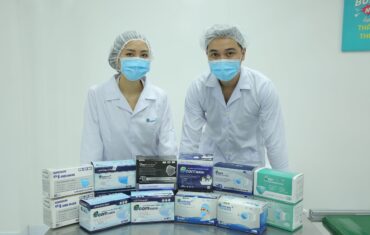Wearing face mask can be uncomfortable or frustrating, especially if you’re not used to it. People who wear glasses, those anxious about being able to breathe properly. Besides, people who wear face masks for extended periods of time face particular challenges. But health workers, who have long used face masks as part of their everyday work, have developed a number of useful workarounds we’d like to share.
How do I stop my glasses fogging up?
For people with glasses, wearing face mask can lead to their lenses fogging, reducing their vision. As you breathe out, your warm breath shoots upwards out the top of the mask. When it hits the colder lens, it cools down, forming condensation, or fogging. Having to keep on taking off your glasses to wipe them clear, and putting them back on again, is an infection risk. So preventing or minimising fogging is the key. Here are some tips:
1. Soap and water – wash your glasses with soap and water then dry them with a microfibre cloth. Facial tissues may leave lint, which attracts moisture to the lenses. Soap reduces surface tension, preventing fog from sticking to the lenses.
2. Shaving foam – apply a thin layer of shaving cream to the inside of your glasses, then gently wipe it off. The residual shaving cream will protect the lenses from misting up.
3. De-misting spray – you can use a commercial de-misting spray that dries clear. But make sure this is compatible with your lens type or existing coatings on your lens.
4. Tape – some health professionals apply a strip of tape that’s specially designed for use on skin to the top edge of the mask to close the gap.
5. Damp tissue – slightly moistening a tissue, folding it and placing it under the top edge of face mask also does the trick.
Sadly, there is no magic trick, such as putting face mask or glasses on first that will stop fogging. Improving the fit around the curve of the nose and cheeks is the best approach.
Don’t feel anxious when wearing a mask
Putting on face mask may make you feel anxious or you may find it hard to breathe normally, especially if you’re new to wearing a mask. Fortunately, the World Health Organisation and others say there is no evidence a face mask will cause either a drop in blood oxygen or an increase in blood carbon dioxide levels for normal everyday activities.
If you do feel anxious about wearing a mask, here are some tips:
1. Practice at home – take a few minutes before leaving the house to get used to the feel of wearing face mask. Slow your breathing, breathe gently, with a slower, longer inhale and exhale while focusing on the fact that air is getting to your lungs, and safely out again.
2. Try another mask – if you still feel breathing is difficult, try a different face mask, use a commercially available design, or use different materials in your next home mask project.
It may take a few attempts to get used to wearing face mask. But with a bit of trial and error, your glasses should remain fog-free, your ears comfortable and any anxiety about wearing a mask should reduce. Wearing a mask in public is another thing we can do to help keep ourselves and the community safe, alongside social distancing and hand hygiene.






